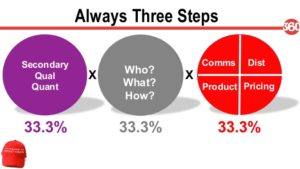Marketing ≠ communication
Everybody knows marketing communication. However, do we really have to consider it as the only important part of marketing?
What marketing is and is not.
Great deal of us read some marketing definitions at college or university and then passed respective exams. These marketing theory definitions have been with us for more than fifty years, so we will remind you of them.
According to the American Marketing Association, marketing is the activity, set of institutions, and processes for creating, communicating, delivering, and exchanging offerings that have value for customers, clients, partners, and society at large.
Keisha M. Cutright, Assistant Professor of Marketing at The Wharton School in Pennsylvania, USA, says that we can consider marketing as an independent organisational unit or as a set of processes focused on understanding the customers and meeting their needs.
Among these issues, there belongs often a decision about what products to make, where to sell them, how to promote them and what are their prices.
Although these principals are more than fifty years old, as mentioned above, nothing about them has changed still. It is not primarily about the product, as many think, it is about the customers and their needs.
That is why we need to realise one thing, closely related, that marketing ≠ communication.
What is communication?
Communication cannot be described simply as an advertisement (ATL, BTL), digital, PR, events and much more. It is a vital part of marketing, the most visible one, but it is still only its part. The communication itself is preceded by a lot of important work that matters in practice the most.
Why is it wrong?
Our little marketing pool mostly tries to figure out what campaign it is doing with no worked out segmentation, knowing nothing about the customers’s motives, not thinking about the product itself, its price, and without a proper strategy to roof it all up for a period longer than the actual three month campaign. Unfortunately, then it happens that the campaign is nice, but useless. Business either stagnates or even goes down. The market share doesn’t move or we even plummet. As we don’t execute surveys, we don’t know if the brand awareness is going up or down, not to mention other useful metrics. And one of the reasons is our approach when we do only communication.
Is it because of the fact that other parts of marketing are boring, or they are not seen, and then we have nothing to boast about at the conferences? Or there is a large number of agencies and they make their clients simply do? Or the Czech marketers don’t have such know-how and have now idea how to work with marketing?
The reasons will be countless, which we can study indefinitely, or we can inspire ourselves by successful approaches, proven in practice and yielding results. Mark Ritson promotes one such interesting approach.
What does such strategy looks like?
Mark Ritson is a professor Adjunct Professor of Marketing at Melbourne Business School, a marketer, who has experience with working for the biggest brands (LVMH, GSK, Pepsico etc.).
Last but not least, he is an excellent speaker who can get attention even from the biggest sleepers of marketing events through his presentations and appearances. To simplify, we can describe this marketing approach in three steps. Analysis, strategy, tactics.
Analysis
The basis is understanding the market and creation of segmentation. Segmentation is not targeting. Segmentation has nothing to do with brand or society. Segmentation can be described as an objective classification of target audiences in the market. Interesting enough, if the competition has the same target audience and does it all right, the same segmentation is achieved. At this stage, we have to find out too, what the customers think. We begin with quantitative research, and the acquired data then verify with qualitative research. Let’s forget what we marketers think and let us listen to the customers.
Strategy
The magical word “strategy” is to mainly define what we will and we will not do over next twelve months. How we will aim based on each segment (typical mistake is - we aim at all). We must set narrow but distinct positioning within the market, coming from where we will stand firm or where not, and what is our goal to represent to the consumer. Lastly, we set clear, measurable, strategic goals for a period not longer than twelve months. At the same time, we can use three simple questions - Who? What? How?
Tactics
Final part of marketing concerns the product development, price formation, distribution and then our favourite discipline - communication. Here we must add, mathematically the communication is only eight percent of marketing. On the top of that, at the end of the whole process. Every area is clearly defined and builds on previous steps. Practically, we can say we still do marketing without communication, and it even delivers. The most important about it is that if we mess up step one or two, we do such communication in vain, as it won’t simply work.
Conclusion
This approach is not an easy one, it requires much work, much persuasion, be it the colleagues, superiors and many other people from the industry who will stubbornly claim that communication = marketing. Let us use follow the principals defined decades ago and are constant. Everything is about the customer, their motives and the ways how to meet their need.



